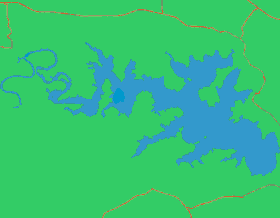Fishing
- Licenses & Regulations
- ShareLunkers
- Fish Identification
- Fish Consumption
- Texas Freshwater Fisheries Center
Water Resources
- Texas Reservoir Levels
- US Army Corps of Engineers
- Texas Water Issues
- Golden Alga
- Aquatic Vegetation
505 Staples Road
San Marcos, Texas 78666
(512) 353-0072
Patrick Ireland, Biologist
Local Information
- Canyon Lake Chamber of Commerce
3934 FM 2673
Canyon Lake, Texas 78133
(830) 964-2223 or (800) 528-2104
Nearby State Parks
Canyon Lake
Quick Links: Fishing Regulations | Angling Opportunities | Cover & Structure | Tips & Tactics
BOATER ADVISORY: Zebra mussels have invaded this reservoir! CLEAN, DRAIN AND DRY your boat, trailer, livewells/bait buckets, and other gear before traveling to another water body. Draining water is required by law and possession and transport of zebra mussels is illegal.
Lake Characteristics
Location: On the Guadalupe River, 16 miles
northwest of New Braunfels in Comal County
Surface area: 8,308 acres
Maximum depth: 125 feet
Impounded: 1964
Water Conditions
Current Lake Level
Conservation Pool Elevation: 909 ft. msl
Fluctuation: Moderate
Normal Clarity: Clear to slightly stained
Consumption Advisory in effect
Reservoir Controlling Authority
US Army
Corps of Engineers
Canyon Project Office
HC-4, Box 400
Canyon Lake, TX 78133-4112
(830) 964-3341
Aquatic Vegetation
None
Predominant Fish Species
Lake Records
Current
Fishing Report
Stocking History
Latest Survey Report
Lake Maps
A general information map is available from USACE (information above). A contour map is sold by private vendors.
Fishing Regulations
All species are currently managed under statewide regulations.
Angling Opportunities
Largemouth bass is the most popular and most abundant sportfish in the reservoir. White bass and striped bass also provide an excellent fishery. Stripers provide excellent angling because of their growth potential and strong fighting characteristics. An annual TPWD stocking program maintains the fishery because striped bass do not successfully reproduce in this reservoir. Crappie fishing is generally poor, although occasionally good catches can be made, especially along standing timber in the river. Angling for redbreast sunfish can provide an excellent fishing experience for the family. Channel, blue, and flathead catfish are present in good numbers. A low density smallmouth bass fishery exists. These fish were stocked in the 1970s and 1980s and persist through natural reproduction. Fishing for smallmouth is better in the lower 1/3 of the reservoir.
| Species | Poor | Fair | Good | Excellent |
|---|---|---|---|---|
| Largemouth Bass | ||||
| Smallmouth Bass | ||||
| Catfish | ||||
| Crappie | ||||
| White & Striped Bass | ||||
| Sunfish |
Fishing Cover/Structure
Canyon Lake is dominated by steep rocky banks, isolated flooded timber, and clear water typical of a highland reservoir. The water becomes stained as one moves up the reservoir and into the river. In most of the lake rock ledges, rock piles, steep drop-offs, flooded timber, and a few marinas provide cover for game fish. Cedar-tree and plastic fish habitat structures have been added to provide additional structure.
Use the Habitat Structure Viewer for an interactive map of fish habitat structures and downloadable GPS coordinates.
The river portion of the reservoir is dominated by flooded timber, rock ledges, and laydowns. When the water level is high, largemouth bass anglers should concentrate on flooded terrestrial vegetation.
Tips & Tactics
Largemouth bass anglers are most successful on Canyon Lake during the spring, fall, and winter months. Bass fishing in summer on this highland reservoir can be difficult even for the most experienced anglers. Topwater baits such as buzzbaits, Zara Spooks, and Pop-R's are popular in the early morning and evening hours. On cloudy days consistent topwater action can occur all day. Crankbaits are also very popular fished along main-lake points, rocky shorelines, and flooded timber. Popular soft plastic baits include worms, spider grubs, grubs, and soft-jerkbaits. Try spinning gear and light line (6-10 lb.) in main-lake clear water situations.
For white and striped bass in the summer and early fall, look for schooling activity around main-lake points and humps. These fish can be caught using topwater baits, jigging spoons, grubs, and rattletraps. Popular techniques for striped bass are trolling with in-line spinners and crankbaits and vertically jigging white bucktail jigs. Live bait presentations for both striped and white bass are popular at all times of the year. White bass spawning migrations occur from February through April. During these months, white and striped bass can be concentrated in the river portion of the reservoir. Anglers catch them using small in-line spinners, small jigs, jigging spoons, small crankbaits, and live bait presentations.
Catfish anglers can find channel, blue, and flathead catfish throughout the reservoir. Channel catfish dominate the fishery. Stinkbait and cutbait work well for channel and blue catfish, while live bait is preferred for flathead catfish. The most consistent catches come from the upper third of the reservoir. Trotlining is very popular for flathead catfish.
